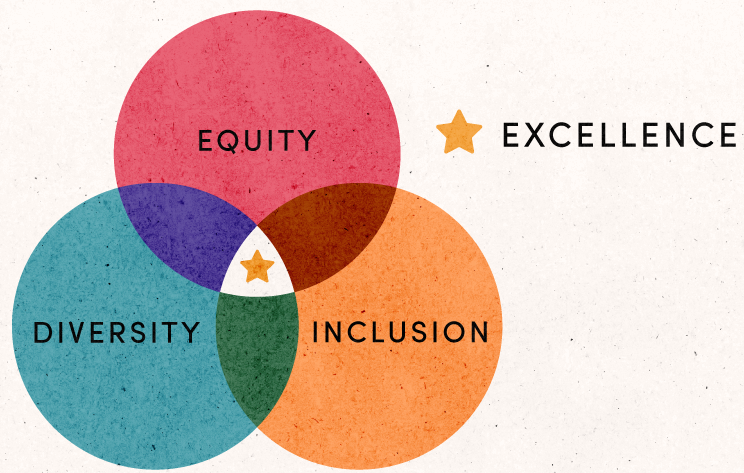eing a leader means that you have the responsibility to support the people on your team and help create a work environment where they can thrive, but it’s not always clear how to do that. Sometimes leaders might face challenging situations related to inclusion or equity on their teams, and figuring out the appropriate way to respond can take a personal toll. But you don't have to do this work alone; there are resources within the organization to support your leadership. One of these resources is your Equity Diversity and Inclusion (EDI) consultant on the Organizational Development team.
These roles were created to support leaders in meeting their EDI goals, including everyday tactics for enhancing EDI on their teams, and in their management of people from all backgrounds.
Intersection of diversity, inclusion, and equity
This space that we operate within, is at that intersection, diversity, inclusion, and equity. Those terms sometimes get thrown around a lot, so let’s define what do we mean by these words from an organizational perspective.

Diversity
Diversity refers to the richness of human experience, the identities, and social groups that we belong to. That can mean race and ethnicity, gender, sexual identity, class, language, faith, veteran status, to name a few.
In an organization, when we talk about diversity, we are really asking who is represented in the organization, who is not, in what job roles and at what levels of leadership. Another way to put it is that diversity is about the numbers: What percentage of women do we have in executive leadership positions? How many people who identify as having a disability work here? What percentage of our organization are people of color? What percentage of our workforce are Baby Boomers? And so on. Diversity looks at the facts of who works here based on the intersectional identities our employees have.
Inclusion
When we talk about inclusion, we're really talking about workplace culture. Do we have a workplace culture in which all employees feel respected and that they can achieve their full potential without barriers due to their identity?
When we're thinking about inclusion, an employee might ask themselves:
-
Do I have a voice here?
-
Can I be my authentic self?
-
Am I part of the team without having to hide pieces of myself?
-
Am I respected by my coworkers and supervisors?
-
Do I have opportunity to grow and advance my career here?
Questions leaders may consider regarding their teams:
- When and where are the opportunities for teammates to share their opinions and perspectives about how we do our work? Can I increase or enhance those opportunities?
- Do we have a team culture that supports employees engaging authentically? What teambuilding opportunities does the team have to share their authentic selves?
- What norms do we have as a team? Are teammates with diverse communication styles, personalities, and cultural backgrounds accepted?
Equity
Equity is thinking of more institutional big picture type of questions. What equity ask us to consider is how we address historic harms and present-day systemic barriers that advantage some groups over others. Some of the big picture questions that equity asks us to think about are:
-
How do we allocate our resources as an organization?
-
How do we provide benefits to a diverse workforce of employees who have different needs?
-
Do we have fair processes for employees related to hiring, mentoring, evaluation, discipline, and so on?
-
How do we think about our cultural norms as an organization, what you have to do to belong or not belong?
Organizations and leaders who make decisions being driven by equity, diversity and inclusion, are operating in a space of excellence.
It’s a space where employees are well cared for and are able to be at their best for patients.
Your EDI Consultants
We get questions about how the work that we do as EDI Consultants relates to some of the other departmental offices that are here to support leaders. In Organizational Development, we work in the realm of culture. We help leaders develop skills to create inclusion within their teams. This is different than what our colleagues in the Office of Equal Opportunity Affirmative Action do. They're here to work in that realm of compliance, ensuring the university complies with our non-discrimination policy, and federal and state laws, and they receive discrimination reports. This is also different than what our HR colleagues in Employee Relations do. They help leaders work with leave requests, ADA accommodations, disciplinary actions, and conduct issues. Although the work of each area is distinct, there may be occasions when all three offices work together on a challenging situation.
What sets our work apart in Organizational Development is our focus on proactive culture work. We work with leaders on how they create and enhance EDI within their departments, within their teams, before something like an OEO report occurs. Or if there have been long-term issues on a team we talk about how you rebuild culture.
As your EDI consultants, here are some ways that we can support your leadership:
-
Tactics for creating inclusive workplaces and respectful team cultures. Working with you and your team to enhance team cohesion and trust.
-
Coaching on inclusive leadership.
-
Hiring and retention strategies.
-
Strategic planning and goal setting, incorporating EDI into your vision for the dept.
-
Reviewing existing practices that you control and consulting on how to make them fairer and more equitable.
And if you have other ideas, we would really love to talk to you about them and explore how we might be able to support you.
Own your power as a leader
In a large organization such as ours, sometimes leaders can feel helpless or hopeless, that there's too much that's out of their control. There are too many things you want to do for your staff that you can't. But we want you to redirect your thinking and focus on the things that you do have control over.
You have a great amount of power when it comes to building the culture of your team and supporting the people who work for you.
Here are some practices we want you to think about in your day-to-day work:
When and how team meetings happen
-
Some things that you should consider: Are we scheduling meetings at times that that are difficult for caregivers, i.e., childcare drop off and pick up times? Are we holding important meetings or retreats on religious or cultural holidays? Are we rotating roles in meetings so that everyone has a chance to experience what it's like to lead in a team space? If we have a hybrid meeting, are we ensuring that everyone can equally listen and participate?
Ongoing culture of feedback and affirmation
-
Frequently we hear from staff that they only seem to get feedback when something's going wrong. Staff long for feedback about what is going right. As a leader, you can think about where do you bring that positive feedback into your team? Is that during one-on-ones? Is that through creating a large public staff recognition of the good work that's happening?
Recognize people with diverse strengths and talents
-
Recognizing people with diverse strengths and talents involves fostering an inclusive environment that values and celebrates individual abilities. We can do this by emphasizing individual strengths, providing stretch assignments and leadership opportunities to all, encouraging collaboration, recognizing, and rewarding achievements, offering training and development, and encouraging open communication.
Creating inclusive and equitable practices
-
When you look at the practices that you control in your unit, center those who have been historically marginalized when you're making decisions.. When we center people who have been underserved, we create practices that work better for everyone. For instance,
-
"Let's review our interviewing practices and think about how they impact people for whom English is not their first language."
-
"Let's review our department communication training practices, and consider how they impact neurodiverse people.”
-
"Let's take a look at our scheduling and ask how it impacts single parents on our team.”
-
“Let's talk about how we've done mentoring, and how we've supported the leadership of women of color on our team before."
By looking through this lens of equity, you're removing barriers that then make the workplace culture better for everyone.
Invest in team belonging
-
Create dedicated time for team building and for learning teamwork skills together.
Address disrespect promptly
-
Be that role model on your team who says, "Disrespect is not tolerated here in any forms." As a leader, you have a great amount of power to shape a culture of respect on your team.
Encourage the sharing of ideas and empower staff to lead
-
Find ways to have your staff continually share ideas and empower them to lead as well.
As your EDI consultants we ask you to reflect on these practices in your day-to-day work. And remember, we are here to support you in making these ideas regular practices on your team.
Clare Lemke
Sheila Sconiers
Asian Americans face unique types of racism and discrimination that can make them feel invisible and out-of-place within our workspaces. By acknowledging this racism, we can take the first step to creating a more inclusive environment.
After receiving feedback from an employee survey, Community Clinics Environmental Services Director Jess Rivera pulled her team together to address workplace discrimination. She shares insights from her journey to break down barriers and create a safe, inclusive work environment for all.
In an era where equity, diversity, and inclusion (EDI) are paramount for organizations striving for meaningful change, the challenges of prioritizing and advancing EDI initiatives have come to the forefront. Experienced EDI professionals William Smith and Katty Youd share valuable insights on the challenges and strategies involved in advancing EDI initiatives, from fostering trust and facilitating conversations to navigating cultural shifts and institutional support.
